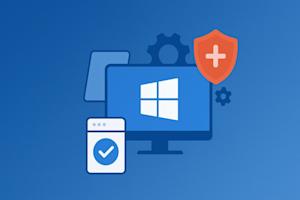Les vulnérabilités zero-day figurent parmi les plus grandes menaces pour les logiciels. Ces vulnérabilités sont des failles logicielles exploitées avant que des correctifs ne soient disponibles, et une fois qu'une vulnérabilité zero-day est connue, les cyberattaquants frappent souvent en quelques heures.
Les équipes TI doivent être capables de détecter, prioriser et corriger rapidement les vulnérabilités avant que les attaquants ne puissent les exploiter. Mais les outils de correction traditionnels ne peuvent pas répondre assez rapidement.
Les entreprises ont besoin de détection des menaces en temps réel et d'une automatisation des correctifs. Avec l'automatisation en temps réel de Splashtop AEM (Gestion autonome des terminaux), les équipes TI peuvent rapidement identifier les terminaux exposés et déployer des correctifs dès que des solutions ou des conseils de mitigation sont disponibles, réduisant ainsi la fenêtre d'exploitation pour les attaquants.
Pourquoi les vulnérabilités Zero-Day sont-elles si dangereuses
Les vulnérabilités Zero-day suivent un cycle de vie standard : découverte, exploitation, divulgation, patching et remédiation. Cependant, comme l'exploitation a lieu avant la divulgation et le patching, cela crée une large fenêtre d'opportunité pour les attaquants d'exploiter la vulnérabilité.
Plus il faut de temps pour corriger une vulnérabilité, plus la probabilité d'une violation est grande. Cependant, même après la sortie d'un correctif, de nombreux points de terminaison peuvent rester non corrigés pendant de longues périodes, les laissant à risque. Ceci est particulièrement difficile dans les environnements à distance ou hybrides, ainsi que pour les entreprises avec des politiques Bring-Your-Own-Device (BYOD), où la gestion des correctifs sur des points de terminaison distants peut être difficile.
Les obstacles communs à une réponse rapide aux vulnérabilités zero-day
Malgré la menace que représentent les vulnérabilités zero-day, les corriger rapidement est souvent plus facile à dire qu'à faire. Plusieurs obstacles peuvent rendre la correction rapide plus difficile qu'elle ne devrait être, y compris :
Cycles de correctifs retardés : Sans correctifs en temps réel, des outils comme Intune ou SCCM fonctionnent sur des synchronisations fixées et peuvent prendre jusqu'à huit heures pour vérifier les nouveaux correctifs. Cela peut laisser les appareils exposés bien plus longtemps qu'il n'est sûr.
Tri manuel : Un manque d'automatisation signifie que les équipes TI doivent examiner manuellement les avis et les bulletins CVE, ce qui facilite la possibilité de manquer des vulnérabilités nouvellement découvertes ou des correctifs récents.
Visibilité limitée : Sans une source de données unifiée, il peut être difficile d'identifier quels appareils sont vulnérables. Cela facilite l'oubli des points de terminaison à risque.
Pas d'automatisation : Sans outils d'automatisation, les correctifs nécessitent une approbation humaine ou une intervention basée sur des scripts, ce qui peut retarder l'approbation et le déploiement.
Chacune de ces étapes peut entraîner un large délai entre la divulgation du CVE et la protection effective, ce qui donne aux cyberattaquants une opportunité d'exploiter les vulnérabilités.
Comment Splashtop AEM accélère la rémédiation des vulnérabilités zero-day
Heureusement, vous pouvez traiter rapidement les vulnérabilités zero-day avec la bonne technologie. Splashtop AEM est une solution robuste et conviviale qui fournit une gestion des correctifs et des vulnérabilités en temps réel sur les points de terminaison et les environnements distribués, permettant aux équipes TI de protéger tous leurs points de terminaison contre les vulnérabilités zero-day.
Avec Splashtop AEM, les organisations peuvent identifier les terminaux affectés et déployer des correctifs en temps réel, garantissant que les mises à jour critiques sont déployées sur les appareils dès qu'elles sont disponibles. Cela minimise le temps nécessaire pour mettre à jour les appareils, les applications et les systèmes d'exploitation, évitant ainsi que les appareils ne restent exposés. Il fonctionne également sur différentes plateformes, y compris Windows, macOS, et les logiciels et applications tiers.
Splashtop AEM utilise l'intelligence intégrée et les insights CVE (Common Vulnerabilities and Exposures) pour identifier les vulnérabilités connues et leurs scores de gravité, permettant aux équipes TI de prioriser les menaces les plus significatives. Les administrateurs peuvent également définir des règles pour le patching automatisé basé sur la politique de l'entreprise, les exigences de conformité et les scores CVE pour corriger automatiquement en priorité les vulnérabilités les plus à risque.
De plus, Splashtop AEM offre une visibilité complète sur les systèmes avec un inventaire automatique et un reporting. Cela aide les équipes TI à identifier quels systèmes sont vulnérables, corrigés ou en attente de remédiation, et offre des enregistrements clairs pour les audits de conformité TI.
Étape par étape : comment identifier et remédier rapidement aux Zero-Days
Alors, comment Splashtop AEM aide-t-il à traiter les vulnérabilités zero-day ? Vous pouvez utiliser Splashtop AEM pour protéger les endpoints contre les vulnérabilités connues et nouvelles en suivant quelques étapes simples :
Surveiller les flux CVE et les insights de vulnérabilité AEM : les insights CVE et les vues de vulnérabilité de Splashtop AEM identifient quels endpoints sont affectés par des vulnérabilités connues, permettant ainsi aux équipes TI d'être toujours conscientes des menaces auxquelles elles sont actuellement confrontées.
Évaluation de la gravité et de l'exploitabilité : Les administrateurs peuvent définir des politiques pour prioriser automatiquement les vulnérabilités en fonction du score CVSS, de la divulgation publique et des données d'exploitation, ou évaluer les menaces eux-mêmes.
Appliquer les politiques de patch d'urgence : lorsqu'une vulnérabilité est détectée, des politiques de patch prédéfinies peuvent déployer des patchs aux endpoints affectés en temps réel.
Vérifier et rapporter la conformité : Une fois les patchs déployés, les équipes TI peuvent confirmer la remédiation réussie dans le tableau de bord de Splashtop AEM et générer des rapports d'audit.
Automatiser pour les Zero-Days Futurs : Les administrateurs peuvent configurer une automatisation continue pour les CVE de haute gravité afin d'assurer une réponse immédiate à tout probl�ème futur qui pourrait survenir.
Pourquoi les Outils Traditionnels Ne Suffisent Pas
Bien que Splashtop AEM soit un outil puissant pour la gestion des correctifs en temps réel et la protection des points de terminaison, de nombreuses organisations ont déjà investi dans d'autres outils de gestion des correctifs. Cependant, les outils traditionnels manquent souvent de rapidité, de flexibilité et de fiabilité pour protéger chaque point de terminaison de manière adéquate.
Certains outils, comme Intune et SCCM, reposent sur des plannings de synchronisation plus lents plutôt que sur des mises à jour en temps réel. Cela signifie qu'il y a souvent de longs écarts entre la sortie d'un correctif et son installation, laissant les points de terminaison vulnérables. Le correctif en temps réel de Splashtop AEM élimine ces retards, maintenant les points de terminaison résolument à jour, et il peut s'associer à des outils comme Intune pour combler les lacunes de patching en temps réel et la couverture des correctifs multi-plateformes.
Certaines organisations peuvent dépendre d'outils manuels, comme des scripts et des feuilles de calcul. Cependant, ceux-ci ne peuvent pas évoluer pour une réponse rapide à travers des endpoints distribués et sont sujets à l'erreur humaine.
De plus, de nombreuses solutions sont conçues pour des systèmes d'exploitation spécifiques et manquent soit de compatibilité multiplateforme, soit de support pour les patchs de logiciels tiers. En conséquence, ces solutions sont incomplètes et laissent exposés des vecteurs d'attaque courants.
Dans l'environnement professionnel actuel, où le travail à distance et le travail hybride sont monnaie courante, et où les employés peuvent utiliser une vaste gamme d'appareils et d'applications, il est plus important que jamais d'utiliser une solution automatisée multiplateforme capable de gérer les points de terminaison distants à travers le réseau d'une entreprise.
Intégration de la rémédiation zero-day dans la sécurité et la conformité
La rémédiation zero-day est essentielle pour maintenir la sécurité et la conformité réglementaire. Cependant, si un audit approche, vous devez tout de même démontrer que vous respectez vos exigences cybersécurité, telles que SOC, PCI, et ISO 27001.
Splashtop AEM est conçu pour aider les organisations à satisfaire aux exigences de patching et de visibilité dans un vaste éventail de cadres de sécurité et à démontrer cette posture avec des rapports prêts pour l'audit. Les équipes TI peuvent générer des rapports montrant les statuts des patchs et les informations CVE, fournissant des informations claires et détaillées sur la manière dont elles protègent et mettent à jour les appareils avec Splashtop AEM pour répondre à leurs exigences réglementaires.
De plus, Splashtop AEM peut aider les entreprises à maintenir la sécurité du réseau. Empêcher les appareils non patchés et non vérifiés de se connecter fait partie des stratégies de sécurité Zero-Trust, et Splashtop AEM peut aider à s'assurer que chaque terminal est correctement à jour et fournir une visibilité sur les statuts des correctifs.
Exemple du Monde Réel : Un Scénario de Réponse Zero-Day
Les vulnérabilités zero-day laissent les réseaux et les appareils vulnérables aux attaques, et elles sont bien plus courantes qu'on ne le penserait.
Par exemple, Google a récemment publié une mise à jour de sécurité d'urgence pour une vulnérabilité zero-day Chrome (CVE-2025-13223) qui ciblait le moteur JavaScript V8 de Chrome, et des hackers ont utilisé une vulnérabilité zero-day pour installer un spyware sur les smartphones Samsung. Des menaces comme celles-ci peuvent compromettre des entreprises entières, donc les organisations et les équipes TI doivent savoir comment y répondre.
Alors, examinons comment Splashtop AEM fonctionnerait dans un tel scénario. Par exemple, si une vulnérabilité zero-day critique est découverte dans Google Chrome, Splashtop AEM recevrait les données CVE sur la vulnérabilité et identifierait instantanément les appareils affectés.
Dès que le patch pour la vulnérabilité est disponible, l'administrateur peut appliquer un patching basé sur des politiques pour déployer la mise à jour de sécurité sur tous les appareils en quelques minutes. Une fois le patch déployé, les agents TI peuvent utiliser le tableau de bord Splashtop AEM pour confirmer la remédiation sur les points de terminaison et créer des journaux de conformité pour vérifier que tous les appareils sont patchés.
En conséquence, l'entreprise peut minimiser les risques et maintenir la conformité TI, tout en économisant du temps et en réduisant le travail manuel généralement requis pour le déploiement des patchs.
Résultats Clés de l'Utilisation de Splashtop AEM pour les Zero-Days
Alors, quels sont les résultats de l'utilisation de Splashtop AEM pour gérer les vulnérabilités zero-day ? Splashtop AEM peut fournir :
Temps plus rapide entre le patch et la protection.
Visibilité unifiée sur tous les appareils, y compris le statut des vulnérabilités et des correctifs.
Conformité continue grâce au suivi automatisé des CVE.
Moins de charge de travail manuel et moins d'erreurs humaines.
Amélioration de la posture de sécurité et de la confiance des clients.
Lorsque les entreprises doivent gérer les patchs et la sécurité dans des environnements de travail à distance et hybrides, il n'y a qu'un seul choix évident. Splashtop AEM offre la sécurité, la rapidité et les informations dont les entreprises ont besoin pour résoudre les vulnérabilités zero-day et protéger leurs endpoints.
Répondre plus rapidement, rester sécurisé
Les vulnérabilités zero-day ne peuvent pas attendre. Le déploiement manuel des patchs et les cycles de patch retardés peuvent laisser les appareils exposés aux attaques, donc une gestion automatisée et en temps réel des patchs est essentielle pour protéger les appareils.
Splashtop AEM offre une gestion des correctifs proactive et automatisée, déployant des mises à jour sur tous les points de terminaison dès qu'elles sont approuvées et disponibles sous vos politiques. Sa combinaison d'automatisation et de visibilité en temps réel offre une protection plus rapide et une conformité de sécurité renforcée, aidant les organisations à améliorer leur sécurité et à se défendre contre les vulnérabilités zero-day aussi rapidement que possible.
Prêt à accélérer votre stratégie de réponse aux menaces zero-day ? Essayez Splashtop AEM avec un essai gratuit et découvrez à quel point c'est facile.





